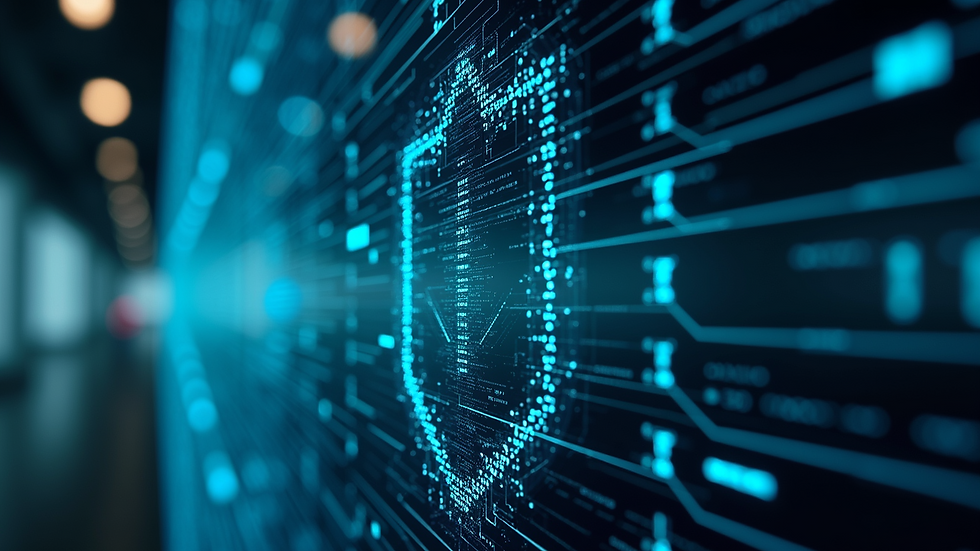The Role of Advanced Tools in Cyber Defence
- BlueShieldTech

- Jul 31, 2025
- 4 min read
In today's digital landscape, the threat of cyberattacks looms larger than ever. With data breaches and ransomware incidents making headlines almost daily, organizations must be proactive in defending their digital assets. The key to effective cyber defence lies in advanced tools that can detect, prevent, and respond to threats efficiently. This blog post will explore various cyber defence tools and their integral role in cybersecurity strategies.
Cyber Defence Tools
Cyber defence tools are essential for safeguarding networks, systems, and data against threats. These tools vary in capabilities, ranging from firewalls to advanced threat detection systems. A well-rounded cybersecurity strategy requires a variety of these tools, which work together to create robust defence mechanisms.
For example, firewalls protect the perimeter of a network by controlling incoming and outgoing traffic. They can be hardware-based or software-based. Intrusion Detection Systems (IDS) monitor network traffic for suspicious activities and send alerts when anomalies are detected. Additionally, Security Information and Event Management (SIEM) systems aggregate and analyze security data from across the organization, providing real-time insights and facilitating quick responses to potential incidents.

The Importance of Threat Intelligence
Threat intelligence plays a vital role in proactive cyber defence. It involves gathering and analyzing data about existing and potential threats to an organization. This can include information about malware, attack vectors, and vulnerabilities. Organizations that leverage threat intelligence can make informed decisions about their cybersecurity posture.
One practical application of threat intelligence is in the realm of endpoint protection. By understanding the latest attack trends, organizations can deploy necessary patches and updates to prevent known vulnerabilities from being exploited. Additionally, threat intelligence can inform incident response plans, ensuring that organizations are prepared to react swiftly to emerging threats.

What is Advanced Cybersecurity?
Advanced cybersecurity refers to the methodologies and practices that go beyond traditional security measures to protect sensitive data and systems. This approach incorporates innovative technologies and strategies to combat increasingly sophisticated cyber threats. Examples include artificial intelligence (AI), machine learning, and behavioral analytics.
AI and machine learning algorithms can analyze vast amounts of data to identify patterns that might indicate a threat. By continuously learning from the data, these systems can adapt and improve their detection capabilities over time. Behavioral analytics focuses on monitoring user behavior to identify any deviations that may signal an attack, such as a user accessing data they typically wouldn't.
The Role of Automation in Cyber Defence
Automation is another critical component in modern cyber defence strategies. With the sheer volume of data and potential threats facing organizations, manual monitoring and response is no longer feasible. Automated tools can help streamline security operations, making them more efficient and effective.
For instance, automated incident response solutions can take predefined actions when a threat is detected, such as isolating an infected device or blocking malicious IP addresses. This not only reduces response time but also minimizes the risk of human error. Organizations can also implement automated compliance checks to ensure they adhere to industry regulations and standards.
Future Trends in Cyber Defence Tools
As technology continues to evolve, so too will the tools used for cyber defence. Emerging trends indicate a shift toward further integration of AI and machine learning into security tools. These technologies will enable organizations to predict and mitigate threats before they become critical issues.
Cloud security tools are also gaining prominence as more organizations migrate to cloud-based infrastructures. These tools will need to address unique challenges, such as multi-tenancy and data privacy, to provide robust protection in a cloud environment. Similarly, the increasing importance of mobile security will drive the development of tools specifically designed to safeguard mobile devices and applications.
Organizations should remain informed about these trends to adapt their cyber defence strategies according to the evolving landscape. Investing in versatile and scalable security tools can provide organizations a competitive edge in protecting their assets.

Implementing an Integrated Cyber Defence Strategy
To maximize the effectiveness of cyber defence tools, organizations should implement an integrated strategy that combines multiple layers of security. This holistic approach involves using various tools and techniques that work together seamlessly.
An integrated cyber defence strategy includes:
Risk Assessment: Regularly evaluate the risks and vulnerabilities within your organization.
Multi-layered Defence: Utilize a combination of firewalls, antivirus software, IDS, and SIEM systems to create layers of security.
Employee Training: Conduct regular training sessions to educate employees on cybersecurity best practices and how to recognize potential threats.
Regular Updates and Patching: Keep all software and systems updated to protect against known vulnerabilities.
Incident Response Plan: Develop and regularly test an incident response plan to ensure readiness when a cyber threat arises.
By adopting this comprehensive approach, organizations can significantly enhance their security posture and reduce the likelihood of successful cyberattacks.
Advanced cybersecurity solutions are integral to creating a dynamic and responsive cyber defence strategy. To learn more about how these solutions can help protect your organization, check out the resources available at Blue Shield.
Staying Ahead in Cyber Defence
The ever-evolving landscape of cyber threats poses ongoing challenges for organizations. However, those willing to invest in advanced tools and strategies will be better positioned to defend their assets and maintain operational continuity.
Regular assessments of cybersecurity practices, staying informed about emerging threats, and continuously updating tools will ensure that organizations can respond effectively to the challenges they face. As the adage goes, it is better to be proactive than reactive. Embracing advanced tools and methodologies in cyber defence will not only enhance security but also instill confidence in stakeholders that their data and systems are well-protected.
.png)



